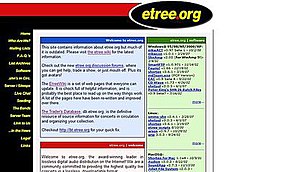Etree
 |
|
 |
|
|
Type of site
|
Live music trading |
|---|---|
| Owner | etree community |
| Created by | Mike Wren |
| Website | etree.org |
| Alexa rank |
|
| Commercial | No |
| Registration | Optional |
| Launched | 1998 |
| Current status | Active |
etree, or electronic tree, is a music community created in the summer of 1998 for the online trading of live concerts. etree pioneered the standards for distributing lossless audio on the net and only permits its users to distribute the music of artists that allow the free taping and trading of their music. The organization describes itself here.
etree.org was created because collectors and curators of live music recordings historically faced four related problems:
First, a problem common to all curators: source material degrades over time. In particular, the magnetic audio tape used to make many live audio recordings physically decays and, as it is repeatedly played back, loses its clarity. Preserving musical source material, therefore, meant restricting access to it. As a result, archival music may have been preserved, but it was not being heard by anyone. Similarly, individuals who possessed live concert recordings were typically unable to store them appropriately (in climate controlled, fire-safe storage, for example) and/or they lacked the ability to make copies for archiving and preservation. Essentially, the musical history of 20th Century concert performances was being lost, locked up in vaults or decaying in attics and living-room bookcases.
Second, copies of analog recordings tend to degrade when copied due to the introduction of hiss or "noise" inherent to the use of magnetic tape. As a result, no two copies are identical, and each copy, or generation, sounds inferior to the generation preceding it.
Third, given the pre-Internet nature of exchanging live recordings (described below) and the fact that the right to copy many such recordings was or is quasi-legal, the provenance, or "lineage" of many recordings was poorly documented. Even today, historians and collectors find much confusion as to date, venue, setlist, etc., in early bootleg recordings. Curators and collectors searching for source material, or simply the best-sounding copy of a concert recording, were required to spend considerable time accumulating multiple copies of the (supposedly) same material, comparing recordings, following up with sources, etc. The presence of fraudsters, commercial bootleggers, and other criminals in this area did not help.
Finally, as a matter of historical preservation, the existence of a single copy of an historical object (whatever it may be) presents a significantly greater risk that the object will be destroyed, damaged or lost than if multiple copies of the object exist. Archivists, therefore, prefer to distribute copies of historical material as widely as possible, to reduce the risk that all copies are destroyed and the object be lost forever.
...
Wikipedia
